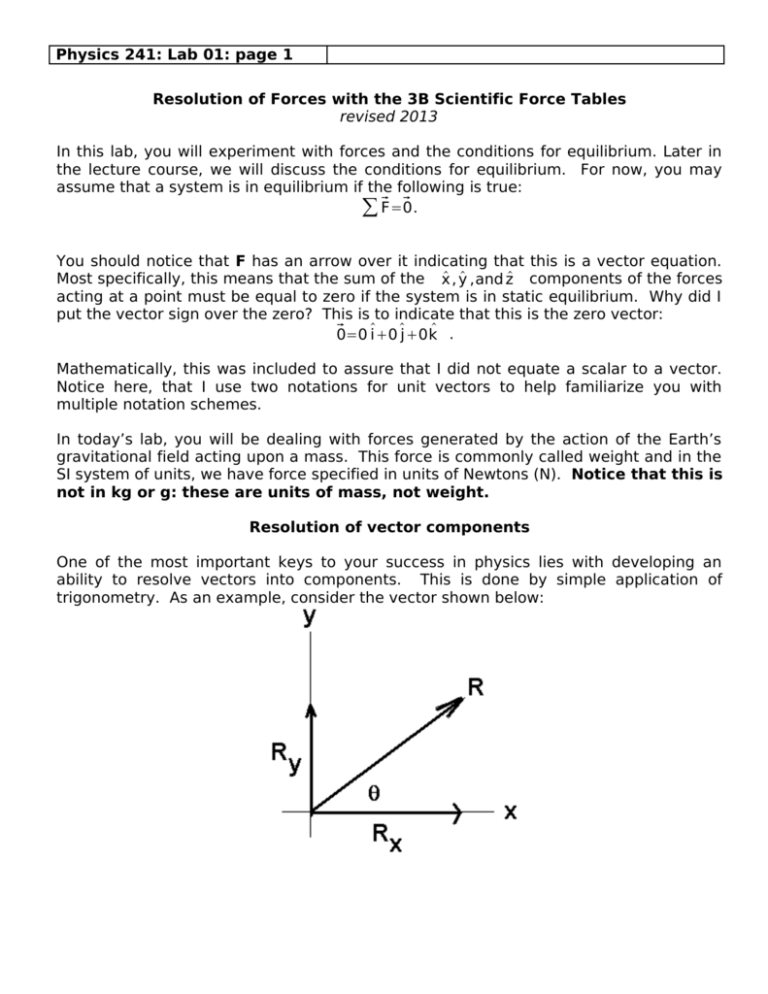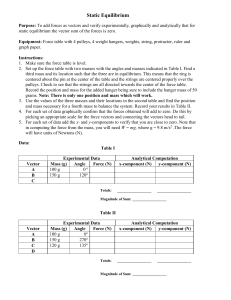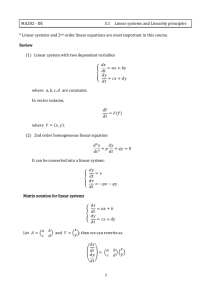Lab 1: Resolution of Forces with the Kennon Force Tables
advertisement

Physics 241: Lab 01: page 1 Resolution of Forces with the 3B Scientific Force Tables revised 2013 In this lab, you will experiment with forces and the conditions for equilibrium. Later in the lecture course, we will discuss the conditions for equilibrium. For now, you may assume that a system is in equilibrium if the following is true: ∑ ⃗F=⃗0. You should notice that F has an arrow over it indicating that this is a vector equation. Most specifically, this means that the sum of the x̂ , ŷ ,and ẑ components of the forces acting at a point must be equal to zero if the system is in static equilibrium. Why did I put the vector sign over the zero? This is to indicate that this is the zero vector: ⃗ 0=0 ̂i+0 ̂j+0 k̂ . Mathematically, this was included to assure that I did not equate a scalar to a vector. Notice here, that I use two notations for unit vectors to help familiarize you with multiple notation schemes. In today’s lab, you will be dealing with forces generated by the action of the Earth’s gravitational field acting upon a mass. This force is commonly called weight and in the SI system of units, we have force specified in units of Newtons (N). Notice that this is not in kg or g: these are units of mass, not weight. Resolution of vector components One of the most important keys to your success in physics lies with developing an ability to resolve vectors into components. This is done by simple application of trigonometry. As an example, consider the vector shown below: Physics 241: Lab 01: page 2 READ THIS! You will need to use this! ⃗ are Rx =R● ⃗ ̂i=| R ⃗ | cos(θ) ⃗ ̂j=| R ⃗ |sin(θ) where The components of R and Ry =R● ̂ ̂ ⃗ R=R x i +Ry j . You must become proficient with these types of vector calculations in ⃗ |= √( R● ⃗ R)= ⃗ √(R2 +R2 ) . You will notice order to have success with physics! Note: | R x y that I have used “dot product” notation here. You must be able to use this vector operation in physics Equipment required: 1 3B Scientific Force Table (assembled) 3 pulleys Hangers with centering ring 1 Mass Kit You may assume the masses are correctly marked and are close enough to be accepted to within other experimental errors during this lab. Each mass kit will contain the following masses before and after the lab: Hanger 1x3 (each weighs 50 g) 5 g mass 2x3 10 g mass 2x3 20 g mass 2x3 50 g mass 2x3 Examine your equipment. If you are in a Monday lab, you will need to assemble the force table at the beginning of your experiment. If you are in the Tuesday lab, you will need to disassemble your force table at the end of your lab. Regardless of which day you are in, you will need to make sure all the weights are returned to the boxes provided in an ordered way after your lab. Place one of the pulleys on the 0 mark so that it will stay. Physics 241: Lab 01: page 3 Example for calculation of a force Suppose your total weight on one string is 55 g. How many Newtons of force is this? Assuming the acceleration due to gravity in the SI system of units is given by: m m ⃗ g=9.8 2 (−ẑ )=−9.8 2 ẑ s s we then find the gravitational force (or weight) by: m ⃗ ⃗ =(55g)(1 kg )(9.8 m2 )(−z)=−0.539 ̂ F=m g =−0.539 N ẑ 1000 g s s2 ⃗ |= √( F● ⃗ F)= ⃗ √ (−0.539N ẑ )●(−0.539N ẑ )=0.539 N |F You should notice how careful I have been to show that the direction of this acceleration is downward. When I write g without a vector symbol, you should m interpret this to be the magnitude of g and has the SI value of 9.8 s2 You will note on the force tables that the function of the pulleys is to change the direction of this force from the downward direction. Note about the sketches: draw them on a piece of paper. You do not need to construct electronic sketches to include with your lab report but you may construct electronic images if you desire. Experiment 1. Place one pulley at 0 0 and place the second pulley at 900. Place a 50 g mass on each of these two pulleys. Rotate the third pulley, varying its mass until the key ring is centered. Record a vector diagram. Note that I am purposely not showing the correct position of force #3. You should draw a circle, representing the situation with all masses and angles recorded on your picture. Then record the forces in the table below. I have a simple spreadsheet calculator that will help you with these calculations on the internet. Note that you do not need to include the sketches for your electronic report for today's lab. M1=______ kg M2=______ kg M3=______ kg F1=_______ N F2=_______ N F3=_______ N F1,x=_______N F2,x=_______N F3,x=_______N ΣFx=_______ N F1,y=_________N F2,y=_________N F3,y=_________N ΣFy=_________ N Physics 241: Lab 01: page 4 Experiment 2. Place 70 g total on holder #1, 125 g total on holder #2. Change the angle for holder #2 to be at 110 0. Vary the mass and angle of holder #3 until equilibrium is established. Record your results in the table below and make a sketch of your system as before. M1=______ kg M2=______ kg M3=______ kg F1=_______ N F2=_______ N F3=_______ N F1,x=_______N F1,y=_________N F2,x=_______N F2,y=_________N F3,x=_______N F3,y=_________N ΣFx=_______ N ΣFy=_________ N Experiment 3. Place 100 g total on holder #1, 50 g total on holder #2. Leave the angle for holder #2 at 110 0. Vary the mass and angle of holder #3 until equilibrium is established. Record your results in the table below and make a sketch of your system as before. M1=______ kg M2=______ kg M3=______ kg F1=_______ N F2=_______ N F3=_______ N F1,x=_______N F2,x=_______N F3,x=_______N ΣFx=_______ N F1,y=_________N F2,y=_________N F3,y=_________N ΣFy=_________ N The analysis Your analysis will consist of observations made during the three experiments and interpretation of your drawings and calculations. You should report how far away from equilibrium your set-up actually was. You should also include details about how you established equilibrium. The Conclusion State and explain the condition for equilibrium. When you found the sum of all forces acting on the ring, you probably did not come up with exactly zero. Why not? Compare the results of experiment 2 and experiment 3 to decide if the error would be greater or smaller if you used larger masses. What was the purpose of experiment 3? Physics 241: Lab 01: page 5 Spreadsheet Calculations Here is an important note: the spreadsheets for these labs are designed to help you through the sometimes complex calculations ... they act like little teaching assistants. However, if you do not learn how they work, you are not using the spreadsheets properly. Thus you are required to learn how the spreadsheet calculations work! Reading across row 2, we have: input mass (g) and input angle(degrees). The ⃗ |=m(9.8)N F |=| m g magnitude of the weight in Newtons is | ⃗ Since the mass is in g, you will need to convert it to kg by: 1 kg m[kg]=m[g] x . 1000 g You will notice that I do this automatically in the calculation. The X component is given by: ⃗ ⃗ ⃗ y=| ⃗ ̂ ̂ cos(θ)=mgcos(θ)⇒ F Fx=F● x=| F || y| F |x=mgcos(θ) x̂ The Y component is given by: ⃗ y=| ̂ ⃗ ̂ ̂ Fy=F● F | | y|cos(90−θ)=mgsin(θ) ⇒⃗ Fy =| ⃗ F| y=mgsin(θ ) ŷ Notice that the spreadsheet calculates angles using radians, rather than degrees. The conversion between radians and degrees is 2 π["rad "] θ[deg]x =θ ["rad"]. 360[deg] If you do not understand the difference between degrees and radians, you should review trigonometry. It is absolutely essential that you understand the difference. This will be extremely important throughout physics. The sum of the components of a force is given by: 3 ̂ ∑ F x=∑ ⃗Fi● x=F 1,x +F2,x +F3,x . i=1 The sum of the magnitudes of the forces is less useful in general but we use it here as a method of comparison. This is given by adding the magnitudes of the individual forces. The percent deviation is given by an unusual formula here. We can not compare to the expected value of zero. Instead we compare to the total force. Thus we have: ∑ F x or ∑ F y . deviation= |∑ ⃗ F| |∑ ⃗ F|








